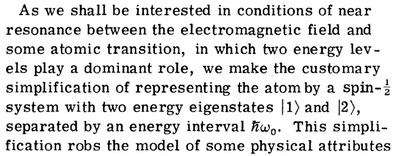Elena & Fabrice's Web
m (→Resonance Fluorescence) |
m |
||
| Line 18: | Line 18: | ||
Here are how various people have described the process: | Here are how various people have described the process: | ||
{{quote|The phenomenon of resonance fluorescence arises with the illumination of an atomic dipole transition by resonant radiation and appears as scattering from the incident beam into other modes of the radiation field.|{{carmichael76a}}}} | {{quote|The phenomenon of resonance fluorescence arises with the illumination of an atomic dipole transition by resonant radiation and appears as scattering from the incident beam into other modes of the radiation field.|{{carmichael76a}}}} | ||
| + | |||
| + | == References == | ||
| + | |||
| + | <references /> | ||
Revision as of 17:10, 16 August 2023
Contents |
Resonance Fluorescence
Resonance Fluorescence is the incoherent light emission (fluorescence) from a system that is being excited at the same frequency than the one at which it naturally emits (resonance).
It is a fundamental problem of great interest to us, for which we are trying to establish a comprehensive timeline. We have been particularly interested in the following aspects of the problem:
- Asymmetries in Resonance Fluorescence — The power spectrum exhibit peculiar symmetrise, which can be broken in a variety of ways.
- Transients in Resonance Fluorescence — Phenomena that occur before the steady state is established.
Simplest as possible, not simpler
The problem is particularly attractive because it is probably the simplest possible, yet highly nontrivial, quantum-mechanical problem, as it can be described with a two-level system. In the words of Kimble and Mandel[1]:

Description
Here are how various people have described the process:
The phenomenon of resonance fluorescence arises with the illumination of an atomic dipole transition by resonant radiation and appears as scattering from the incident beam into other modes of the radiation field.